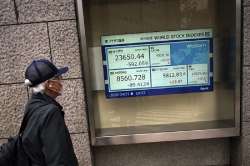Oil price plunges below zero as demand collapses; Asian shares skid
Traders are still paying more than $20 for a barrel of U.S. oil to be delivered in June, which analysts consider to be closer to the “true” price of oil. Crude to be delivered next month, meanwhile, is running up against a stark problem: traders are running out of places to keep it, as factories, automobiles and airplanes sit idled around the world.

Asian shares skidded on Tuesday after U.S. oil futures plunged below zero as storage for crude runs close to full amid a worldwide glut as demand collapses due to the pandemic. Shares fell in Tokyo, Hong Kong and Shanghai but New York stock futures edged higher after the S&P 500 sank 1.8% overnight, giving up some big gains from last week. In a stunning development, the cost to have a barrel of U.S. crude delivered in May plummeted to negative $37.63. It was at roughly $60 at the start of the year.
Traders are still paying more than $20 for a barrel of U.S. oil to be delivered in June, which analysts consider to be closer to the “true” price of oil. Crude to be delivered next month, meanwhile, is running up against a stark problem: traders are running out of places to keep it, as factories, automobiles and airplanes sit idled around the world.
“We could merely be in the eye of the hurricane as the epicentres of its rage remain centred around demand devastation and crude oil oversupply,” Stephen Innes of AxiCorp. said in a commentary.
“At a minimum, oil prices will be the last asset class to recover from lockdown. End transport demand will only occur in the final stages of reopening when border crossing is allowed, and travel restrictions get lifted,” he said.
Tanks at a key energy hub in Oklahoma could hit their limits within three weeks, according to Chris Midgley, head of analytics at S&P Global Platts. Because of that, traders are willing to pay others to take that oil for delivery in May off their hands, so long as they also take the burden of figuring out where to keep it.
“Almost by definition, crude oil has never fallen more than 100%, which is what happened today,” said Dave Ernsberger, global head of pricing and market insight at S&P Global Platts.
“I don’t think any of us can really believe what we saw today,” he said. “This kind of rewrites the economics of oil trading.”
Few traders are buying and selling U.S. oil to be delivered in May. When trading contracts for it expire on Tuesday, the earliest delivery they’ll be able to buy is for June.
Brent crude, the international standard, fell nearly 9% on Monday to $25.57 per barrel.
Early Tuesday, U.S. crude for June delivery had gained $1.24 to $21.67 per barrel in electronic trading on the New York Mercantile Exchange. Brent crude, the standard for international oil pricing, had edged 3 cents higher, to $25.67.
Monday’s plunge in oil sent energy stocks in the S&P 500 to a 3.7% loss, the latest in a dismal 2020 that has caused their prices to nearly halve.
Halliburton reported a stronger first-quarter profit than expected but said the pandemic has created so much turmoil in the industry that it “cannot reasonably estimate” how long the hit to demand will last.
The S&P 500 fell 51.40 points to 2,823.16. The Dow Jones Industrial Average lost 2.4% to 23,650.44, and the Nasdaq dropped 1%, to 8,560.73.
Gains from companies that are winners in the new stay-at-home economy helped limit the market’s losses.
Netflix jumped 3.4% to set another record as people while away the hours and days shut-in at home. Amazon added 0.8%.
In Asia, Tokyo’s Nikkei 225 fell 1.3% to 19,419.07 while the Hang Seng index in Hong Kong lost 1.9% to 23,875.03. South Korea’s Kospi fell 1.9%, to 1,861.99.
Australia’s S&P/ASX 200 fell 0.5% to 5,325.80 and the Shanghai Composite index gave up 0.9% to 2,826.41.
In a sign of continued caution in the market, Treasury yields remained extremely low. The yield on the 10-year Treasury was steady at 0.62%.
In currency trading, the dollar fetched 107.65 Japanese yen, almost unchanged from 107.63 on Monday. The euro fell to $1.0844 from $1.0862.
Stocks have been on a general upward swing recently, buoyed by promises of massive aid for the economy and markets by the Federal Reserve and U.S. government.
More recently, countries around the world have tentatively eased up on business-shutdown restrictions meant to slow the spread of the virus.
But health experts warn the pandemic is far from over and new flareups could ignite if governments allow a premature rush to ”normal” life.
The S&P 500 remains nearly 17% below its record high as millions more U.S. workers filing for unemployment every week amid the shutdowns.
Many analysts also warn that some of the recent rally for stocks is based on overly optimistic expectations for a fast economic rebound once shutdowns end.
“There’s still uncertainty surrounding the reopening of the economy,” said Julian Emanuel, chief equity and derivatives strategist at BTIG. “Come fall, are we going to be back on airplanes? Are we going to go out and eat?”
Also Read | Oil prices plunge below zero as demand collapses, stocks dip
Also Read | India tightens curb on import of refined palm oil